Contemporary Research in Boron Chemistry
Shih-Yuan
Liu
 a and
Douglas W.
Stephan
a and
Douglas W.
Stephan
 b
b
aDepartment of Chemistry, Boston College, Chestnut Hill, Massachusetts, USA. E-mail: shihyuan.liu@bc.edu
bDepartment of Chemistry, University of Toronto, 80 St. George St, Toronto, Canada. E-mail: douglas.stephan@utoronto.ca
The Boron in the Americas Conference (BORAM XVI) was held in the summer of 2018 at Boston College. More than 200 delegates from all over the world came together at the conference to learn about the latest developments in boron chemistry. It was during the meeting when the idea of putting together a special issue of Chemical Society Reviews began to take shape with the goal to showcase the diversity and reach of contemporary research in boron chemistry.
Boron research emerged from humble beginnings in the field of inorganic chemistry. The synthesis and electronic structure elucidation of diborane in the first half of the 20th century initiated the rich field of boron hydride chemistry (including polyhedral boron cluster compounds) and subsequently organoboron chemistry, which ultimately led to three Nobel Prizes (1976, 1979 and 2010). Despite this success, boron chemistry has by no means reached its peak. Indeed, new exciting discoveries of boron-containing compounds continue to evolve. Examples include:
• new synthetic methodologies utilizing organoboron compounds as reagents and catalysts
• new activation modes for small molecules and bonds mediated by boron compounds
• new opportunities to create chemical space and function via BN/CC isosterism,
• new boron-doped carbon-rich materials with distinct optoelectronic properties
• new applications for boron clusters
The scientific program of BORAM XVI highlighted the diversity of such advances, demonstrating the versatility of the element boron in four research areas: biomedical research, organic synthesis, materials chemistry, and fundamental chemistry. To document the excitement, we asked some of the speakers representing each of the areas to contribute to the special issue.
In the biomedical realm, Hey-Hawkins and colleagues (DOI: 10.1039/C9CS00197B) describe new carborane-containing drugs, while Góis et al. (DOI: 10.1039/C9CS00184K) review the use of boronic acids in the construction of bioconjugate therapeutic agents. Advances in the use of boron chemistry for organic synthesis is also highlighted with reviews from the groups of Liu (DOI: 10.1039/C9CS00218A) and Morken (DOI: 10.1039/C9CS00180H) on strategies for the functionalization of BN-heterocycles and unique catalyst-promoted reactions involving metalate shifts, respectively. In addition, Hall (DOI: 10.1039/C9CS00191C) describes boronic acid catalysis, while Xie et al. (DOI: 10.1039/C9CS00169G) report on transition metal catalyzed functionalization of o-carboranes. Recent advances in materials applications of boron chemistry are detailed in several reviews. L-S. Wang and coworkers (DOI: 10.1039/C9CS00233B) probe the nature of boron and doped-boron clusters. S. Wang's team reports on the recent development of their boron-based compounds that are stimuli responsive (DOI: 10.1039/C9CS00153K). Finally, new fundamental aspects of boron chemistry are described. Kinjo and Su (DOI: 10.1039/C9CS00072K) describe the use of boron-based heterocycles in the activation of small molecules, while Stephan and coworkers (DOI: 10.1039/C8CS00277K) report on the use of boron-based FLPs in hydrogenation catalysis, as well as on radicals derived from Lewis acids and bases (DOI: 10.1039/C8CS00940F).
It is our hope that this collection of cutting-edge reviews transmits the excitement within the boron chemistry community to the reader. In our view, this issue, while focused on the chemistry of a single element, demonstrates the broad range of innovative applications of boron-based compounds. This seems a highly appropriate way to celebrate 2019, the International Year of the Periodic Table!
| This journal is © The Royal Society of Chemistry 2019 |


